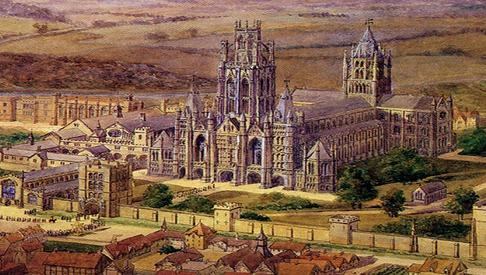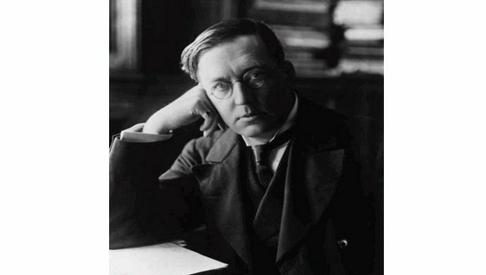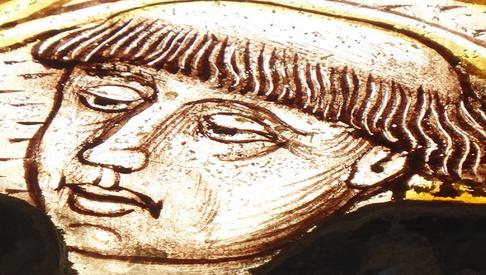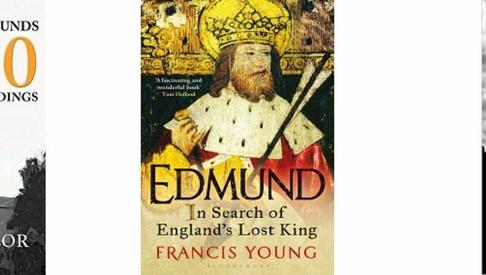
Back to Blogs
Discover
43 Facts About the Abbey of St Edmund
The Abbey of St Edmund was one of the most famous and wealthy pilgrimage locations in England - discover 43 Facts on the Abbey!
43 Facts on the Abbey of St Edmund by Local Historian and Author Martyn Taylor
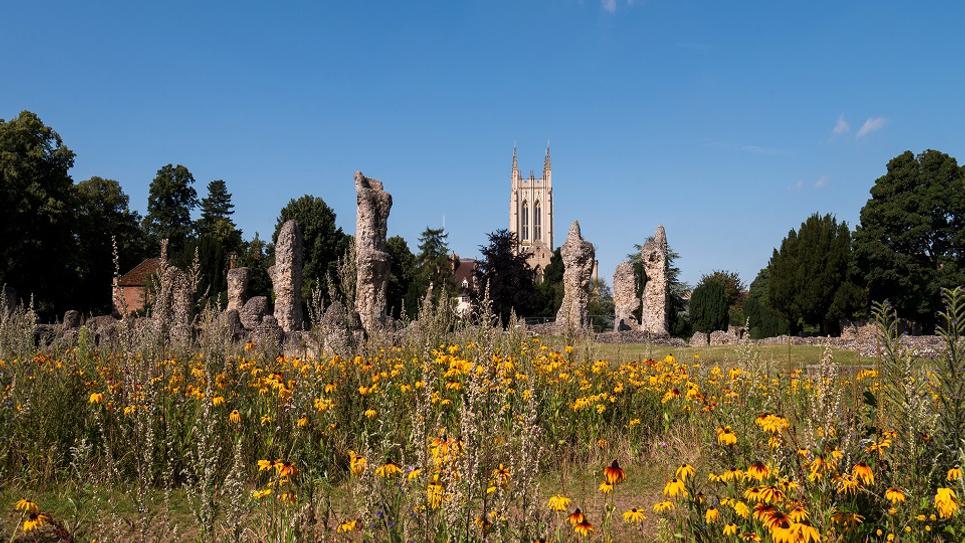
1. The Abbey church was the largest Romanesque church in Northern Europe.
2. If Henry VIII had not dissolved the Abbey in 1539, the Abbey Church would have become an enormous cathedral or minster and Bury St Edmunds by now would be a city, probably larger than York, Durham or Lincoln.
3. Edward the Confessor visited St Edmund's shrine; the last mile barefoot.
4. Henry VI visited the Abbey in 1433 at Christmas staying until Easter 1434 with his large entourage. It cost the Abbey a fortune to feed them!
5. At least 14 sovereigns have visited Bury St Edmunds and its Abbey. The last was Queen Elizabeth II when she gave out Maundy money in 2009.
6. Dame Elizabeth Frink’s fine statue of St Edmund commemorates the loss of West Suffolk as a county when it joined East Suffolk in 1974 to become Suffolk.
7. During the refurbishment of the Abbey’s West Front (in 2005/6) a worn track in the flintwork was discovered caused by the monk’s hobnailed sandals.
8. According to famous academic and ghost writer, M R James, the three niches above the portcullis, which is a Victorian replacement, may have had statues of St Edmund flanked by two Danish archers.
9. The last Abbot John Reeve, aka De Melford, was given a huge pension on his ejection but died without collecting it. Some say of a broken heart!
10. The Abbey’s Vinefields faced North-West, which was unusual as usually grapevines faced South to take full advantage of the sun.
11. The River Linnet was diverted to form a mill pond near to where the Abbot's bridge is, the townspeople could not grind their grain in any other mill.
12. In 1772 the embalmed body of Thomas Beaufort, Duke of Exeter who led the English rear guard at the battle of Agincourt, was found near the Lady Chapel. He had died at East Greenwich in 1427 and his will dictated he was to be buried by his Duchess at the Abbey of St Edmund.
13. The last great procession to enter the abbey church through the central arch was that of Mary Tudor, Queen of France who died of the Tudor Curse, the dreaded sweating sickness in 1533. But her brother King Henry VIII and her husband Charles Brandon, the Duke of Suffolk, did not attend. When the Abbey was dissolved she was moved to St Mary's Church, her final resting place.
14. An officer of the Abbey was known as an Obedientiary, a follower of the rules of St Benedict (hence Benedictine), they all held specific roles, for example the Sacrist looked after the infrastructure of the Abbey but also could collect the dung from the streets.
15. Another interesting role was that of the Refectorarius or Comptroller who looked after the refectory (dining hall) supplying crockery, table linen, furniture, mats, he was also responsible for putting rushes and straw on the floor and importantly doling out cheese.
16. There were Latin names for many of the officers, a version of an Almoner gave alms to the poor. The Pitancer collected small parcels of food left from the monk’s meals to give to the poor. Small being the operative word, which led to the phrase ‘not working for a pittance’.
17. After the dissolution, the poor of the town had to rely on the generosity of the Guildhall Feoffees to help look after them.
18. Any Abbey stone taken from the Abbey can be found mostly in cellars in the town, although a wall outside the Farmers Club in Pump Lane is entirely of limestone ashlar blocks. Abbey stone is unlikely to be found any further than 6 miles out because it would have taken a cart a day to the Abbey & a day back.
19. The intense heat of the 2018 summer showed via parch marks hidden walls of parts of the Abbey.
20. The Norman Tower was built by Anselm, an Italian abbot 1120-48 and is referred to as a Campanile, a stand-alone belfry.
21. In 1785, Thomas Osborn of Downham Market Bell Foundry hung ten bells in the Norman Tower the only complete set ever in any belfry at one time.
22. No known images of the Abbey church survive but the footprint of the ruins tells us the size of the church.

23. When the Norman Conquest happened in 1066, Bury St Edmunds did not need a castle to subdue the inhabitants of the town. The town had Baldwin, a French Abbot of the Abbey which controlled the town.
24. Baldwin laid out the ancient medieval grid still evident today thus making it possibly the oldest such in the country.
25. There were thirty-three abbots during the 500 plus years of the Abbey's existence, six buried in the Chapter House were disinterred on New Year's Day 1903, five of which were re-buried in their own coffins.
26. The refurbished Abbots Palace was demolished by Major Richardson Pack in 1720/21 even though he had paid a lot of money for it.
27. The Abbey's Warming House was the only part of the Abbey where any form of heat was allowed for the monks.
28. The South Trancept of the Abbey Church is shorter than the North Trancept.
29. In 1845 someone fell though the floor of the Charnel House, a consecrated bone depository from 1300, and found themselves surrounded by thousands of bones in the crypt.
30. There were three large archways into the Abbey's West Front. The central arch was reserved for royalty, upper members of society along with clergy. The facing left arch was for the thousands of pilgrims who came to see St Edmund's Shrine over the centuries enter. The right arch was the exit.
31. A tympanum, a sculpture of Jesus Christ, that was across the rounded arch of the Norman Tower was removed in 1789 to allow the passage of carts.
32. There were once turrets on the Abbey Gate, one on the Norman Tower as well as a clock.
33. The Norman Tower (also known as St James Tower) was the religious gateway to the Abbey Church, the Abbey Gate, the secular or non-religious gate.
34. There are small stone sculptures on the rear of the Abbey Gate including that of a cat and a pig.
35. So called Stars of David on the front of the Abbey Gate have nothing to do with the Jewish faith as when this gateway was built between 1327 and 1347, they had been expelled from England for 137 years. They possibly relate to a Double Trinity.
36. Facing Churchgate Street on the Norman Tower at the top of a stone column there are small stone sculptures of a male lion, lioness and cub between them. Born supposedly dead it was believed in medieval times that the breath of the parents brought the cub to life.
37. It was once thought that 25 Barons met on November 20th 1214 to compel King John to agree to the Charter of Liberties (which led to the Magna Carta) which would have been St Edmund's Day. However, it has been now proved they met in October of 1214.
38. Not only was Edmund venerated here but also his religious relics such as his nail parings, shirt and sword.
39. Others were: relating to St Lawrence, the coals he was roasted on, pieces of the Holy Cross plus Thomas A Becket ‘s penknife.
40. There was a stone dovecote in the Abbey, their flesh and eggs were very important.
41. The Crankles or fishponds, twisting waterways were also very important for the monks diet as they were not supposed to eat flesh!
42. Monks drank large amounts of weak beer as its brewing process killed harmful bacteria.
43. Is Edmund really buried in the monk’s cemetery (where the new wildflower labyrinth is now situated and formerly tennis courts)? Theories abound that he could be in an iron bound chest.
1000 years since the founding of the Abbey of St Edmund will be marked with a year of celebrations in 2022. Find out more with our Abbey 1000 Guide!
Related Posts
Related Blogs

News
Abbey Project Awarded…
The project aims to conserve and protect the ruins;…

News
Cycle the Wolf Way
Winding its way around many of the best bridleways,…
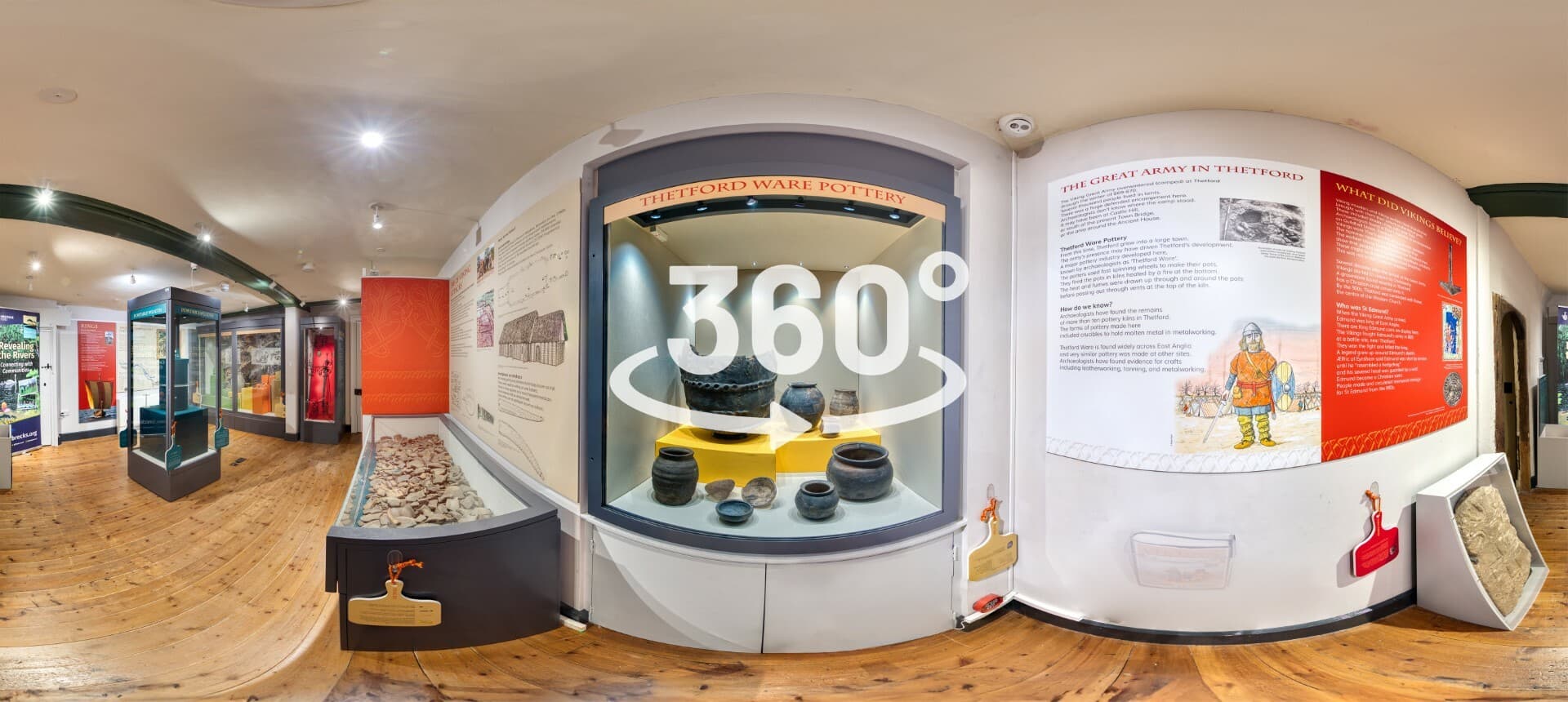
News
360° Degree Vikings
The Brecks Fen Edge and Rivers Landscape Partnership…

News
Dame Barbara Woodward DCMG…
Dame Barbara Woodward DCMG OBE Announced as Speaker at…

News
Celebrate St Edmund's Day on…
St Edmund's Day is celebrated around the world every…
Latest news

News
Discover Suffolk's County Flower - the Oxlip
Did you know that Suffolk has a county flower? The Oxlip only grows in some woodland areas of Suffolk, Cambridgeshire and Essex.

News
Quentin Blake ‘The Illustrated Hospital’ exhibition at Bury St Edmunds Museum
A summer exhibition of illustrations by Quentin Blake at Moyse’s Hall Museum, Bury St Edmunds presents a rare opportunity to view a large collection of pieces by one of the nation’s favourite artists.

News
Abbey Project Awarded National Lottery Heritage Fund Grant
The project aims to conserve and protect the ruins; build a visitor centre, west cloister, and network of footpaths; and use digital technology to provide exciting interpretation for all ages and…

News
Walks at Rougham
Rougham Estate offers 18 miles of public footpaths, cycling routes and permissive pathways for you to enjoy.

News
Bury St Edmunds Celebrates English Tourism Week
Bury St Edmunds MP, Jo Churchill, met representatives from the town’s attractions and tour guides involved with the town’s Masters of the Air tourism campaign at Bury St Edmunds Guildhall.

News
Tours Take Off for Masters of The Air
Tours developed by Bury St Edmunds Tour Guides and Bury St Edmunds Guildhall to tie in with the Apple TV Series Masters of The Air so popular more dates are being added.

News
International illustrator David Hughes draws largest exhibition Bury St Edmunds
The largest ever exhibition is now underway at Moyse’s Hall Museum featuring the work of internationally acclaimed illustrator David Hughes.

News
A Taste of Bury St Edmunds and Suffolk
After visiting Suffolk's foodie capital, you'll want to take it with you - here are 5 foodie treats to take home!

News
Doctor Who Stars Coming to Bury St Edmunds to Star in Sherlock Holmes Classic
Who stars Colin Baker, Terry Molloy, and Rosie Baker will star in Hound of The Baskervilles at Bury St Edmunds Theatre Royal

